香港朗文2AChapter2教案
- 格式:pdf
- 大小:29.62 KB
- 文档页数:12
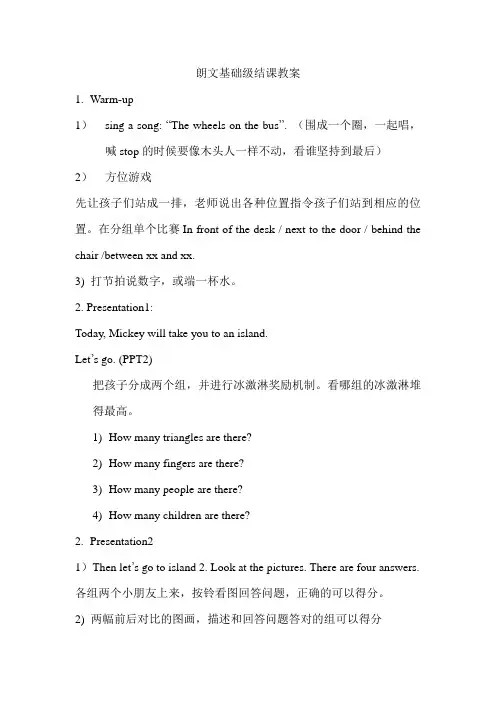
朗文基础级结课教案1.Warm-up1)sing a song: “The wheels on the bus”. (围成一个圈,一起唱,喊stop的时候要像木头人一样不动,看谁坚持到最后)2)方位游戏先让孩子们站成一排,老师说出各种位置指令孩子们站到相应的位置。
在分组单个比赛In front of the desk / next to the door / behind the chair /between xx and xx.3) 打节拍说数字,或端一杯水。
2. Presentation1:Today, Mickey will take you to an island.Let’s go. (PPT2)把孩子分成两个组,并进行冰激淋奖励机制。
看哪组的冰激淋堆得最高。
1)How many triangles are there?2)How many fingers are there?3)How many people are there?4)How many children are there?2.Presentation21)Then let’s go to island 2. Look at the pictures. There are four answers. 各组两个小朋友上来,按铃看图回答问题,正确的可以得分。
2) 两幅前后对比的图画,描述和回答问题答对的组可以得分3. Presentation 3 (PPT10-PPT12)1) Where is the cat?2) Where is the bear?3) Where is Jerry?4) Where is Tom?5) Mickey lost her way, can you help him?让小朋友们帮助Mickey 找到去路。
同样是分组比赛得分。
4.Presentation 4 (ppt13-ppt14)让小朋友认读单词,并从图上找出相应物品5.Presentation 5 (PPT15-PPT16)1)比赛认读单词,2)互相提问。
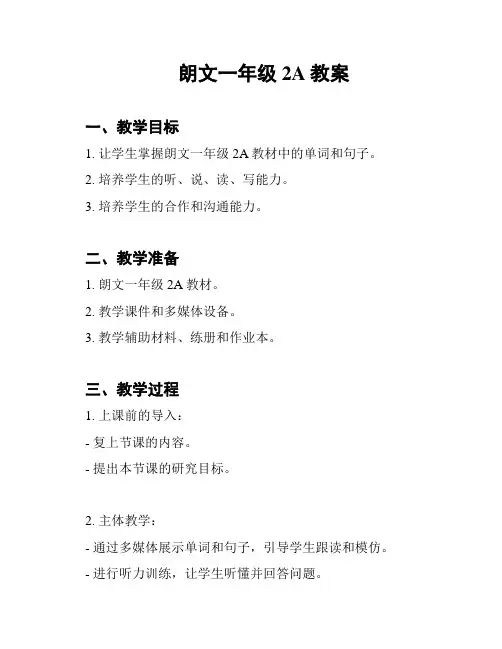
朗文一年级2A教案
一、教学目标
1. 让学生掌握朗文一年级2A教材中的单词和句子。
2. 培养学生的听、说、读、写能力。
3. 培养学生的合作和沟通能力。
二、教学准备
1. 朗文一年级2A教材。
2. 教学课件和多媒体设备。
3. 教学辅助材料、练册和作业本。
三、教学过程
1. 上课前的导入:
- 复上节课的内容。
- 提出本节课的研究目标。
2. 主体教学:
- 通过多媒体展示单词和句子,引导学生跟读和模仿。
- 进行听力训练,让学生听懂并回答问题。
- 进行口语训练,让学生用所学句子进行对话练。
- 进行阅读训练,让学生读懂课文并回答问题。
- 进行写作练,让学生根据图片或问题写句子。
3. 课堂巩固:
- 师生互动讨论课堂内容。
- 提问学生,检查学生的理解和掌握情况。
4. 课后作业:
- 布置相应的练册和作业本的题。
- 鼓励学生复所学内容并做好相关练。
四、教学评价
1. 教学中可以通过观察学生的表现和听答案的方式进行评价。
2. 考察学生对单词、句子、对话和课文的掌握情况。
3. 给予学生积极的反馈和建议,激励他们进一步提高。
五、教学反思
1. 教师需根据实际情况调整教学策略,确保教学效果最大化。
2. 反思学生的表现和反馈,思考教学方法和材料是否需要改进。
3. 根据教学反思,制定下一节课的教学计划。
以上为朗文一年级2A教案的大致框架,具体教学细节和内容可根据实际情况进行调整和修改。
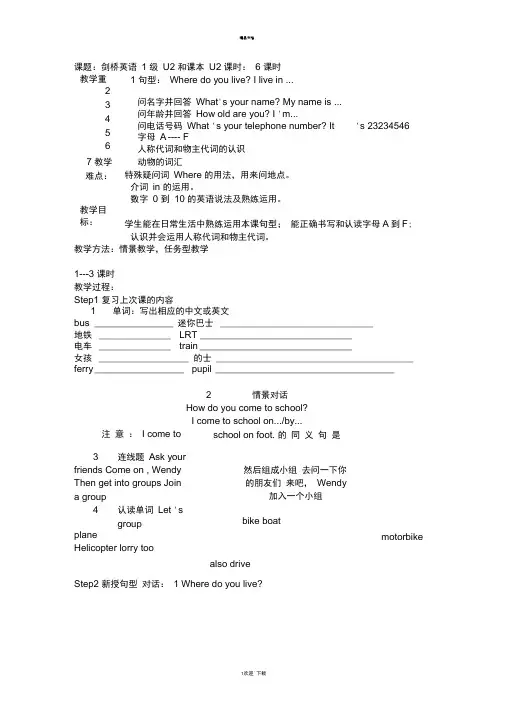
课题:剑桥英语 1 级 U2 和课本 U2 课时: 6 课时 教学重点: 1 句型: Where do you live? I live in ...23 4 5 6 7 教学难点: 问名字并回答 What 's your name? My name is ... 问年龄并回答 How old are you? I 'm... 问电话号码 What 's your telephone number? It 's 23234546 字母 A ---- F 人称代词和物主代词的认识动物的词汇 特殊疑问词 Where 的用法,用来问地点。
介词 in 的运用。
数字 0 到 10 的英语说法及熟练运用。
教学目标: 学生能在日常生活中熟练运用本课句型; 能正确书写和认读字母A 到F ;认识并会运用人称代词和物主代词。
教学方法:情景教学,任务型教学1---3 课时教学过程:Step1 复习上次课的内容1 单词:写出相应的中文或英文bus _______________ 迷你巴士 __________________________________地铁 ________________ LRT _____________________________电车 ________________ train _____________________________女孩 ____________________ 的士 ____________________________________________ ferry _________________ pupil __________________________________2 情景对话How do you come to school?I come to school on.../by...注 意 : I come to Step2 新授句型 对话: 1 Where do you live?school on foot. 的 同 义 句 是3 连线题 Ask yourfriends Come on , WendyThen get into groups Joina group4 认读单词 Let 'sgroupplaneHelicopter lorry too然后组成小组 去问一下你的朋友们 来吧, Wendy 加入一个小组 bike boat also drivemotorbikeI live in... (换不同的地点练习) 2What 's your name?My name is Kitty.(互问)3 复习0 到10 的数字的英语表达出示数字卡片,让学生说英语,或者老师说英语学生反应数字。
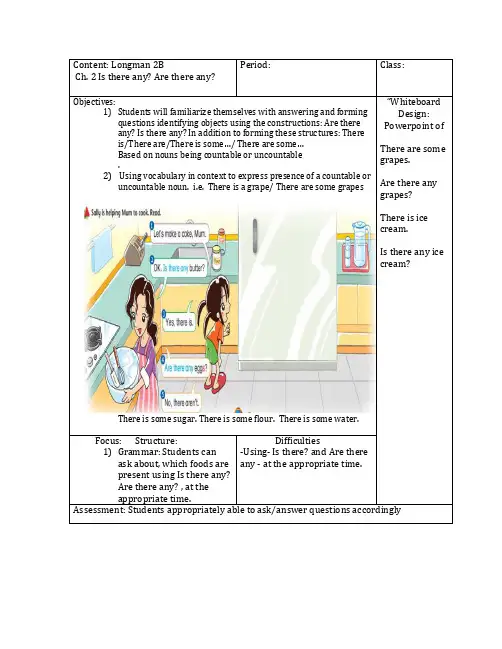

朗文国际英语教程第二册
抱歉,由于法律和版权限制,我无法提供完整的朗文国际英语教程第二册的文本。
然而,我可以向您提供一些关于使用该教程的建议和提示。
1. 课前准备:在每节课之前,先预习本节课所涉及的单词和语法知识。
可以通过朗文国际英语教程第二册的课前练习和习题来加深理解。
2. 听力练习:从第一课开始,听英语原声录音,并尝试理解和模仿发音和语调。
重复听写更有助于提高听力技巧和解析能力。
3. 词汇积累:每个单元都会介绍新单词和短语,建议制作一个词汇表格,包括单词、释义和例句。
可以再多写一些与这些单词相关的句子,以便更好地运用。
每天进行一些词汇练习,例如使用词卡进行背诵或进行拼写练习。
4. 口语练习:利用课本中提供的对话和练习题,和朋友、同学或语言学习伙伴一起进行对话练习。
尝试使用课本中的句子和表达方式来进行自由对话,并积极参与课堂讨论。
5. 写作练习:根据课本中的写作练习题,练习书写一些简单的句子和段落。
可利用语法和词汇工具书来查找更多的表达方式和写作技巧。
6. 语法学习:注意课本中的语法部分,理解语法规则并进行相关练习。
可以通过阅读其他英语语法书籍或参考网上的学习资
源来巩固语法知识。
7. 阅读理解:多读英语文章,可以选择与课本主题相关的文章,提高阅读理解能力。
通过阅读能够拓展词汇量,了解英语的使用方式和常见表达法。
记住持之以恒,多练习将有助于提高听说读写的能力。
祝您学习顺利!。
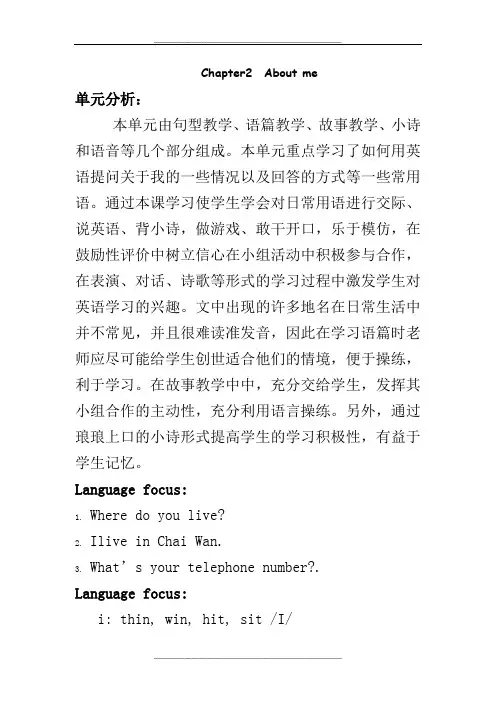
Chapter2 About me单元分析:本单元由句型教学、语篇教学、故事教学、小诗和语音等几个部分组成。
本单元重点学习了如何用英语提问关于我的一些情况以及回答的方式等一些常用语。
通过本课学习使学生学会对日常用语进行交际、说英语、背小诗,做游戏、敢干开口,乐于模仿,在鼓励性评价中树立信心在小组活动中积极参与合作,在表演、对话、诗歌等形式的学习过程中激发学生对英语学习的兴趣。
文中出现的许多地名在日常生活中并不常见,并且很难读准发音,因此在学习语篇时老师应尽可能给学生创世适合他们的情境,便于操练,利于学习。
在故事教学中中,充分交给学生,发挥其小组合作的主动性,充分利用语言操练。
另外,通过琅琅上口的小诗形式提高学生的学习积极性,有益于学生记忆。
Language focus:1.Where do you live?2.Ilive in Chai Wan.3.What’s your telephone number?.Language focus:i: thin, win, hit, sit /I/Text types:conversations, stories, maps, stories, telephone books, poems教具准备:PPT、图片。
课时安排:本单元共安排五课时Chapter2 About me (Period 1)一、Teaching contents:《International Edition Longman Welcome to English》Chapter2 About me Part A二、Teaching aims1. Aims of knowledgea. To introduce pupils to different means of places in Hong Kong.b. To encourage pupils to learn the names of some districts in Hong Kong.c. To encourage pupils to ask and answer about the ways they come to school.d. Ask and answer about the districts they live in .2. Aims of abilitiesa. Use simple sentences to communicate with others.b. Use interrogative pronouns to find out specific information about transport inHong Kong.c. To establish and maintain relationships and routines in carring out classroomactivities.33.Aims of emotionDevelop participatory, cooperative, love and caring attitudes三、Difficult and key pointsKey points:a.To encourage pupils to learn the names of some districts in Hong Kong.b. Pupils learn the names of different means of districts in Hong Kong.c.To encourage pupils to ask and answer about the ways they come to school. Difficult points:To introduce pupils to know the pronunciations of districts in Hong Kong.四、Teaching aids1. flash cards2. PPT五、T eaching procedure:Step 1. Warm-up1. Greetings2. Warm-up activities.3.Talk with the SsStep 2. Presentation1. Good morning class! Nice to meet you .What’s the weather like today ? What day is it today?2. What’s this ?It’s a map .Look . We can find some places from this map .Do you know where w e are ? We are in Xi’an . Xi’an is a good place. Show the area of Xi’an. I live in… Show the question Where do you live ? Find a student to answer .Then teach the question Where do you live ? and the answer by using together ,group by group ,one by one .Then ,Go round the class asking pupils where they live .It doesn’t matter if they all answer with the same district . The most important thing is that they understand the concept.Now ,look ,this is the New Territories .This is Kowloon .This is Hong KongIsland .Let’s learn it together .Teach different names of the New Territories by using the flash cards.This is ….3.Teach the question form. Then go round the class asking questions and elicitinganswers.Do you know here ?This is …4.Ok ,listen to the E –book and follow .5.Little teacher6.Boys and girls read ,7.IndividualsStep 3. Conclusion1.Let the Ss talk with their partner by using the questions they have learned.2.Read the new words and have a competition(let each of a group come to the board to have a competition ,who is quicker ,I will give a star )3. Ask who can read the names of places .六、Homework1.Copy the words 3 times and try to remember them.2.Follow the CD read part A七、 Blackboard writingChapter2 About me (Period 2)一、 Teaching contents:《International Edition Longman Welcome to English》Chapter2 About me (Period2) Part A & PartB二、Teaching aims1. Aims of knowledgea. To interpret and use simple given information through processes or activitiessuch as labeling, matching, sequencing, describing, classifying; and to follow simple instructionsb. To introduce pupils to different means of places in Hong Kong.c. To encourage pupils to learn the names of some districts in Hong Kong.d. To encourage pupils to ask and answer about the ways they come to school.e. Ask and answer about the districts they live in .2. Aims of abilitiesa. Use simple sentences to communicate with others.b. Use interrogative pronouns to find out specific information about transport inHong Kong.c. To establish and maintain relationships and routines in carry out classroomactivities.3. Aims of emotionDevelop participatory, cooperative, love and caring attitudes三、Difficult and key pointsKey points:a.To encourage pupils to learn the names of some districts in Hong Kong.b.Pupils learn the names of different means of districts in Hong Kong.c.To encourage pupils to ask and answer about the ways they come to school. Difficult points:a. To introduce pupils to know the pronunciations of districts in Hong Kong.四、Teaching aids1.Flash cards2.PPT五、Teaching procedure:Step1. Warm-up1. Greetings2. Warm-up activities.3.Talk with the SsStep 2. Presentation1.Good morning class! Good morning. What’s the weather like today ? What day is it today?2.Ok ! You did a nice job ,who can answer my question ? Look at the screen .(PPT).Review the words they have learn. Using the flash cards, cover them and ask pupils to spell them keep repeatingReview the sentence byW here do you live ? I live in … ask questions and let them answer.Correct them when they were wrong.3. Ask questions “Where does Sally live ?” and let them listen to the sampleconversations in part A .After listening the students should answer the teach er’s question.4. Follow the CD to read the part A together. Then group by group. (Ok ,let’s havea competition ,who is better I will give a sticker)5. Listen to the E-book again ,point and say .6 .Boys and girls read ,7.Little teacher8.Well, let’s go ahead , who want to show us this conversation ,hands up .(choosetwo Ss to act the conversation)Step 5.Consolidation1.Let the Ss talk with their partner and do the Part B together.A: where do you live, xxx?B: I live in … .2.Check the answer3.Act conversatione the sentences they have learned instead of the text.六、 Homework1. Recite part A.2.Act the part A to your parents3.Ask and answer part B in pairs.七、 Blackboard writing七、Reflection after class:Chapter2 About me ( Period 3)一、Teaching Contents《朗文英语》2A Chapter 2第三课时 Part C&D二、 Teaching aims1. Aims of knowledgea.To develop pupils’ reading skills and stimulate their critical thinking ability.b.To obtain and provide information in simple classroom situations and through activities such as interactive games and role-play.c. To provide or find out and present simple information on familiar topics.e. Use the simple present tense to express opinions.2. Aims of abilitiesa. To provide or find out and present simple information on familiar topicsb. Use interrogative pronouns to find out specific information about some places in Hong Kong.e simple sentences to communicate with others .3.Aims of emotiona..Develop participatory, cooperative ,love and caring attitudesb. To develop pupils’reading skills and stimulate their critical thinking ability.三、Difficult and key pointsa.Pupils learn to ask and answer about the ways they come to school and other’s telephone number.b.Pupils learn some pronunciation of new words .四、Teaching aidsFlash card , CD , super E-book五、T eaching procedure:1. Warm up1) Greet to pupils2). Warm-up activities.3).Talk with the Ss2. Presentation1). Good morning class! Good morning. How are you? What’s the weather like today? What day is it today?2). Ok ! You are great . who can answer my question ? look at the screen .(PPT). What does the teacher want to know? What do the pupils need to do ?(Arouse pupils’ interest in reading by asking questions)3).Ask questions about the story .How many Girls are there in the story?Do they know each other?4). Introduce the topic of telephone numbers.Do you have a telephone at home?If you want to get in touch with your friends, you need to know their telephone numbers.5).Teach the question what’s your telephone number? And the way to say telephone numbers. Teach 0 as zero or oh. Teach double and triple for repeated numbers, e.g.33=double three, 444=triple four. Practise with different numbers.T; My telephone number is … W hat’s y our telephone number, May?Pl: It’s…T: Thank you. What about you, tony? What’s your telephone number?P2:It’s …T: Good. Thank you.6).Pre-teach any new words.7).Tell pupils to read the story once silently.8).Ask questions about the story.What’s the name of mary’s new friend?(kitty.)Where’s mary’s telephone number?(2333 4440.)Are the two girls neighbours?(yes.)9).Get pupils to act the story in groups. Ask one or two groups with lively intonation and reasonably accurate pronunciation to come to the front to perform.10). Check pupils’ answers to part D.11). Listen to the E-book again , point and say .12).Boys and girls read ,Little teacher3.Consolidation1).Read the text2).Let them practise some telephone number4.Homework1). Read part C and try to recite it.2).Ask your friend’s telephone number六、. Blackboard writingChapter2About meHow do Mary and Kitty meet ?Where do they live ?七、Reflection after classChapter2 About me (Period 4)一、Teaching Contents《朗文英语》2A Chapter 2第四课时 Part E二、 Teaching aims1. Aims of knowledgea.To get pupils to practice using questions previously learnt to ask for personal information.b.To obtain and provide information in simple classroom situations and through activities such as interactive games and role-play.c.To get pupils to practice talking about more about their friends .2.Aims of abilitiesa.To establish and maintain relationships and routines in carrying out classroom activities.b.To interpret and use simple given information through processes or activities such as labeling, matching, sequencing, describing, classifying; and to follow simple instructions.c.To get pupils to practice talking with others.3.Aims of emotiona. Develop confidence in using English through performing tasks on their own or in groups.b.Develop participatory, cooperative, love and caring attitudes.三、Difficult and key pointsa.To get pupils to practice talking about more about their friends .b.Appreciate the beauty of the language through enjoying reading simple conversations.c.Remind pupils of the difference between How are you ?and How old are you ?.d.To provide or find out and present simple information on familiar topics.四、Teaching aidsFlash card , CD , super E-book五、T eaching procedure:1. Warm up1). Greet to pupils2). Warm-up activities.3).Talk with the Ss.2. Presentation1). Hello, class! Good morning. Nice to meet you What’s the weather like today? What day is it today?2).Talk with a studentHello,…How old are you ?Where do you live ?How do you come to school ?What is your telephone number ?Ok ! You are great. Ok ,you are so clever3).Now who can ask questions like me ?(Ask a pupil to come to the stage )4).Ok ,excellent .Now talk with your partners.In pairs ,pupils act Tom and the teacher .They ask and answer questions based on the information provided on the blackboard .Go round the class checking their understanding.6)Listen to the E-book7)point and say . Read the sample conversations in partE.8).Follow the CD to read part E together. Then group by group .(Ok ,let’s have a competition ,who is better I will give a sticker) 9.Boys and girls read ,9).Little teacher10).Check pupils’answers to Part E.3.Consolidation1). Let the Ss talk with their partner by using the basic questions.2)Tell Ss to find out more informations about their friends.4.Homework1).Read part E and try to recite it .2).Act the part E to your parents六、. Blackboard writingChapter2 About meHow old …?----.Where …?I live in …七、Reflection after classChapter2 About me (Period 5)一、Teaching Contents《朗文英语》2A Chapter 2第五课时 PartF &Phonics二、 Teaching aims1. Aims of knowledgea.To enable to pupils to enjoy and appreciate the English Language through a poem.b.To recognise some obvious features of the English language in simple spoken and written texts such as the direction of writing in English, the characteristics of an alphabetic script and the sound patterns of English; and apply this awareness to one’s initial learning and use of the language.c.To develp an awareness and an enjoyment of the basic sound patterns of English in imaginative texts through activities such as participating in action rhymes, singing songs and choral speakinge.Get pupils to look at the PPT while they pronounce the /i/.2.Aims of abilitiesa.To recognize some obvious feature of the English Language in simple spoken and written texts such as the direction of writing in English ,the characteristics of an alphabetic script and the sound patterns of English ;and apply this awareness to one’s initial learning and use of the language .b.To develop an awareness and an enjoyment of the basic sound patterns of English inimaginative texts through activities such as participating in action rhymes singing songs and choral speaking .3. Aims of emotionAppreciate the beauty of the language through enjoying reading simple conversations.三、Difficult and key points1. Get pupils to look at the PPT while they pronounce the /i/.2. To enable to pupils to enjoy and appreciate the English Language through a poem.3.Get pupils to pronounce the /i/ in different words.四、Teaching aidsFlash card , CD , super E-book五、T eaching procedure:1. Warm up1). Greet to pupils2). Warm-up activities.3).Talk with the Ss2.Presentation1). Hi, class! Good morning. Nice to see you What’s the weather like today? What day is it today?2). Play the poem and tell pupils to follow.3). Read out the poem and tell pupils to listen carefully.4).Explain any words or expressions which pupils may find difficult to understand. 5).Pupils read the lines of the poem after you. Try to ensure the chanting does not become too slow or expressionless.6).Invite pupils to read out the poem in groups or individually for the whole class. Give encouragement and recognition for their performance.Play the poem again and ask pupils to read poem along .7).Listen to the E-book point and say .8).Boys and girls read ,9).Little teacher10). Follow CD play the phonics game in the super E-Book .11).Get pupils to look at your mouth while you pronounce the/I/sound or play the video in the Super E-Book. Look at my mouth and read after me.12)Play the phonics game in the super E-book.Ask pupils if they know the similarity between the words thin and win. Tell them that the words have the same middle sound. Do the same with the other two words (hit and sit).Check pupils’ pronunciation of the/I/sounds by asking them to say the words tin and fit.(the/t/and/f/ sounds are taught in p1.)Make sure they use the short vowel/I/, not the long/i:/.Ask pupils to say other known words with the same sound.3.Consolidation1) . Let the Ss talk with their partner how to read the poem. Let each of a group come to the board to have a competition ,who is better, I will give a star。
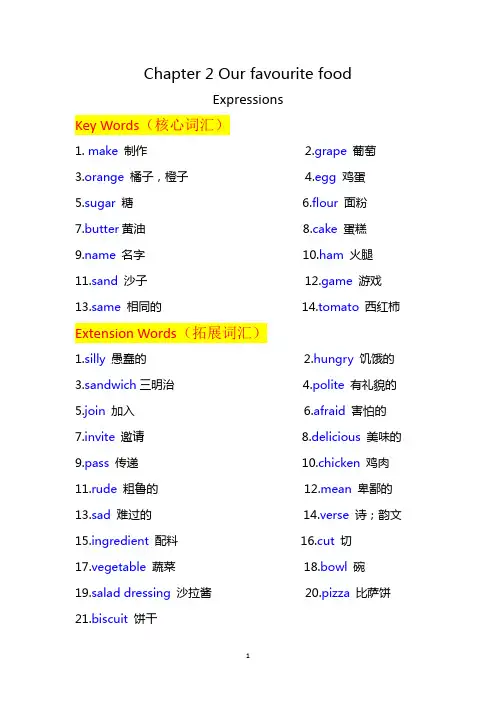
Chapter 2 Our favourite foodExpressionsKey Words(核心词汇)1.make制作2.grape葡萄3.orange橘子,橙子4.egg 鸡蛋5.sugar糖6.flour面粉7.butter黄油8.cake蛋糕名字10.ham火腿11.sand沙子12.game游戏13.same相同的14.tomato西红柿Extension Words(拓展词汇)1.silly愚蠢的2.hungry饥饿的3.sandwich三明治4.polite有礼貌的5.join加入6.afraid害怕的7.invite邀请8.delicious 美味的9.pass 传递10.chicken 鸡肉11.rude 粗鲁的12.mean 卑鄙的13.sad 难过的14.verse 诗;韵文15.ingredient配料16.cut 切17.vegetable蔬菜18.bowl 碗19.salad dressing 沙拉酱20.pizza 比萨饼21.biscuit饼干Key Sentences(核心句型)1.Let’s make a cake,Mum.让我们来做个蛋糕吧,妈妈。
2.Is there any butter ? 有一些黄油吗?3.Yes , there is. 是的,有。
4.No, there isn’t. 不,没有。
5.Are there any eggs ?有一些鸡蛋吗?6.Yes, there are.是的,有。
7.No, there aren’t.不,没有。
Extension Sentences(拓展句型)1.They want to join the party. 他们想去参加聚会。
2.Would you like to join us ? 你想加入我们吗?3.Can you pass the chicken , please ?请你把鸡肉递给我,好吗?4.You can come to my birthday party every year .你们每年都能来参加我的生日派对。

讲义Chapter2第一课时一、单词二、词组三、翻译下面句子。
1.She is seven years old._________________________2.She has small ears and big eyes._________________________________3.She studies in the library after school every day. _________________________________4.Kiki’s dad is a teacher._________________________________5.He does not study and he does not help at home._________________________________6.I hope we can be friends forever!_________________________________重点难点一、 do/does的运用方法。
1.do/does后面+动词原形Do you go to school by bus?Does your father is a teacher?2.用do/does来提问的句子,用do/does来回答。
--Do you like English?--Yes,i do.--Does Lily like dancing?--Yes,she does.3.do/does的否定形式。
does not=doesn’tdo not=don’tShe doesn’t go to school today.=__________________I do not like singing.=___________________________二、复习动词的第三人称单数变化规则。
1.判断第三人称单数的方法:1.不是我2.不是你3.一个人2.第三人称有"他"﹑"她"﹑"它"﹑"及一些单数名词。
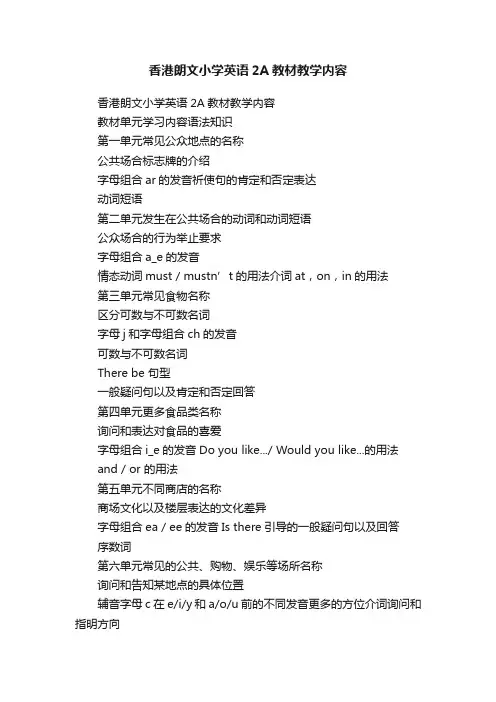
香港朗文小学英语2A教材教学内容
香港朗文小学英语2A教材教学内容
教材单元学习内容语法知识
第一单元常见公众地点的名称
公共场合标志牌的介绍
字母组合ar的发音祈使句的肯定和否定表达
动词短语
第二单元发生在公共场合的动词和动词短语
公众场合的行为举止要求
字母组合a_e的发音
情态动词must / mustn’t的用法介词at,on,in的用法
第三单元常见食物名称
区分可数与不可数名词
字母j和字母组合ch的发音
可数与不可数名词
There be 句型
一般疑问句以及肯定和否定回答
第四单元更多食品类名称
询问和表达对食品的喜爱
字母组合i_e的发音Do you like.../ Would you like...的用法
and / or 的用法
第五单元不同商店的名称
商场文化以及楼层表达的文化差异
字母组合ea / ee的发音Is there引导的一般疑问句以及回答
序数词
第六单元常见的公共、购物、娱乐等场所名称
询问和告知某地点的具体位置
辅音字母c在e/i/y 和a/o/u前的不同发音更多的方位介词询问和指明方向
第七单元常见的动物名称
对事物的外形和特点进行描述
字母组合o_e的发音
第三人称单数
表示事物特征的形容词复习have / has的用法。


Chapter2 About me单元分析:本单元由句型教学、语篇教学、故事教学、小诗和语音等几个部分组成。
本单元重点学习了如何用英语提问关于我的一些情况以及回答的方式等一些常用语。
通过本课学习使学生学会对日常用语进行交际、说英语、背小诗,做游戏、敢干开口,乐于模仿,在鼓励性评价中树立信心在小组活动中积极参与合作,在表演、对话、诗歌等形式的学习过程中激发学生对英语学习的兴趣。
文中出现的许多地名在日常生活中并不常见,并且很难读准发音,因此在学习语篇时老师应尽可能给学生创世适合他们的情境,便于操练,利于学习。
在故事教学中中,充分交给学生,发挥其小组合作的主动性,充分利用语言操练。
另外,通过琅琅上口的小诗形式提高学生的学习积极性,有益于学生记忆。
Language focus:1.Where do you live?2.Ilive in Chai Wan.3.What’s your telephone number?.Language focus:i: thin, win, hit, sit /I/Text types:conversations, stories, maps, stories, telephone books, poems教具准备:PPT、图片。
课时安排:本单元共安排五课时Chapter2 About me (Period 1)一、Teaching contents:《International Edition Longman Welcome to English》Chapter2 About me Part A二、Teaching aims1. Aims of knowledgea. To introduce pupils to different means of places in Hong Kong.b. To encourage pupils to learn the names of some districts in Hong Kong.c. To encourage pupils to ask and answer about the ways they come to school.d. Ask and answer about the districts they live in .2. Aims of abilitiesa. Use simple sentences to communicate with others.b. Use interrogative pronouns to find out specific information about transport inHong Kong.c. To establish and maintain relationships and routines in carring out classroomof emotionDevelop participatory, cooperative, love and caring attitudes三、Difficult and key pointsKey points:encourage pupils to learn the names of some districts in Hong Kong.b. Pupils learn the names of different means of districts in Hong Kong.encourage pupils to ask and answer about the ways they come to school.Difficult points:To introduce pupils to know the pronunciations of districts in Hong Kong.四、Teaching aids1. flash cards2. PPT五、T eaching procedure:Step 1. Warm-up1. Greetings2. Warm-up activities.with the SsStep 2. Presentation1. Good morning class! Nice to meet you .What’s the weather like today ? What day is it today?2. What’s this ?It’s a map .Look . We can find some places from this map .Do you know where weare ? We are in Xi’an . Xi’anis a good place. Show the area of Xi’an. I live inShowthe question Where do you live ? Find a student to answer .Then teach the questionWhere do you live ? and the answer by using together ,group by group ,one byone .Then ,Go round the class askin g pupils where they live .It doesn’t matter if they all answer with the same district . The most important thing is that they understand theconcept.Now ,look ,this is the New Territories .This is Kowloon .This is Hong KongIsland .Let’s learn it together.Teach different names of the New Territories by using the flash cards.This is ….the question form. Then go round the class asking questions and elicitinganswers.Do you know here ?This is …,listen to the E –book and follow .teacherand girls read ,Step 3. Conclusionthe Ss talk with their partner by using the questions they have learned.the new words and have a competition(let each of a group come to the boardto have a competition ,who is quicker ,I will give a star )3. Ask who can read the names of places .六、Homework1.Copy the words 3 times and try to remember them.2.Follow the CD read part A七、 Blackboard writing八、Reflection after class: Chapter2 About meWeather DateGroup A B CA: Where do you live?B: I live in … .Sha Tin Tuen Mun Tsuen Wan KowloonMong Kok Kwun Tong Chai Wan Wan ChaiChapter2 About me (Period 2)一、 Teaching contents:《International Edition Longman Welcome to English》Chapter2 About me (Period2) Part A & PartB二、Teaching aims1. Aims of knowledgea. To interpret and use simple given information through processes or activitiessuch as labeling, matching, sequencing, describing, classifying; and to follow simple instructionsb. To introduce pupils to different means of places in Hong Kong.c. To encourage pupils to learn the names of some districts in Hong Kong.d. To encourage pupils to ask and answer about the ways they come to school.e. Ask and answer about the districts they live in .2. Aims of abilitiesa. Use simple sentences to communicate with others.b. Use interrogative pronouns to find out specific information about transport inHong Kong.c. To establish and maintain relationships and routines in carry out classroomactivities.3. Aims of emotionDevelop participatory, cooperative, love and caring attitudes三、Difficult and key pointsKey points:encourage pupils to learn the names of some districts in Hong Kong.learn the names of different means of districts in Hong Kong.encourage pupils to ask and answer about the ways they come to school.Difficult points:a. To introduce pupils to know the pronunciations of districts in Hong Kong.四、Teaching aidscards五、Teaching procedure:Step1. Warm-up1. Greetings2. Warm-up activities.with the SsStep 2. Presentationthe weather like today ? What day is it morning class! Good morning. What’stoday?! You did a nice job ,who can answer my question ? Look at the screen .(PPT).Review the words they have learn. Using the flash cards, cover them and askpupils to spell them keep repeatingReview the sentence byWhere do you live ? I live in … ask questions and let them answer.Correct them when they were wrong.and let them listen to the sample3. Ask questions “Wheredoes Sally live ?” conversations in part A .After listening the students should answer the teacher’s question.4. Follow the CD to read the part A together. Then group by group. (Ok ,leta competition ,who is better I will give a sticker)5. Listen to the E-book again ,point and say .6 .Boys and girls read ,teacher, let’s go ahead , who want to show us this conversation ,hands up .(choose two Ss to act the conversation)Stepthe Ss talk with their partner and do the Part B together.A: where do you live, xxx?B: I live in … .the answerconversationthe sentences they have learned instead of the text.六、 Homework1. Recite part A.the part A to your parentsand answer part B in pairs.七、 Blackboard writing七、Reflection after class:Chapter2 About me( Period 3)一、Teaching Contents《朗文英语》2A Chapter 2第三课时 Part C&D二、 Teaching aims1. Aims of knowledge develop pupils’reading skills and stimulate their critical thinking ability. obtain and provide information in simple classroom situations and through activities such as interactive games and role-play.c. To provide or find out and present simple information on familiar topics. e. Use the simple present tense to express opinions.2. Aims of abilitiesa. To provide or find out and present simple information on familiar topicsb. Use interrogative pronouns to find out specific information about some places in Hong Kong.simple sentences to communicate with others . 3.Aims of emotiona..Develop participatory, cooperative ,love and caring attitudesb. To develop pupils’reading skills and stimulate their critical thinking ability.Chapter2 About meA: Where do you live ,xxx ? B: I live in… .Sha Tin Tuen Mun Tsuen Wan Kowloon Mong KokKwun TongChai WanWan Chai三、Difficult and key pointslearn to ask and answer about the ways they come to school and other’s telephone number.learn some pronunciation of new words .四、Teaching aidsFlash card , CD , super E-book五、Teaching procedure:1. Warm up1) Greet to pupils2). Warm-up activities.3).Talk with the Ss2. Presentation1). Good morning class! Good morning. How are you? What’s the weather like today?What day is it today?2). Ok ! You are great . who can answer my question ? look at the screen .(PPT). Whatdoes the teacher want to know? What do the pupils need to do ?(Arouse pupils’ interest in reading by asking questions)3).Ask questions about the story .How many Girls are there in the story?Do they know each other?4). Introduce the topic of telephone you have a telephone at home?If you want to get in touch with your friends, you need to know their telephonenumbers.5).Teach the question what’s your telephone number? And the way to say telephonenumbers. Teach 0 as zero or oh. Teach double and triple for repeated numbers, three, 444=triple four. Practise with different numbers.W hat’s your telephone number, May?T; My telephone n umber is … Pl: It’s…T: Thank you. What about you, tony? What’s your telephone number?P2:It’s …T: Good. Thank you.6).Pre-teach any new words.7).Tell pupils to read the story once silently.8).Ask questions about the story.What’s the name of mary’s new friend?(kitty.)Where’s mary’s telephone number?(2333 4440.)Are the two girls neighbours?(yes.)9).Get pupils to act the story in groups. Ask one or two groups with lively intonationand reasonably accurate pronunciation to come to the front to perform.10). Check pupils’ answers to part D.11). Listen to the E-book again , point and say .12).Boys and girls read ,Little teacher3.Consolidation1).Read the text2).Let them practise some telephone number1). Read part C and try to recite it.2).Ask your friend’s telephone number六、. Blackboard writingChapter2About meHow do Mary and Kitty meet ?Where do they live ?七、Reflection after classChapter2 About me (Period 4)一、Teaching Contents《朗文英语》2A Chapter 2第四课时 Part E二、 Teaching aims1. Aims of knowledgeget pupils to practice using questions previously learnt to ask for personal information.obtain and provide information in simple classroom situations and through activitiessuch as interactive games and role-play.get pupils to practice talking about more about their friends .2.Aims of abilitiesestablish and maintain relationships and routines in carrying out classroom activities.interpret and use simple given information through processes or activities such aslabeling, matching, sequencing, describing, classifying; and to follow simple instructions.get pupils to practice talking with others.3.Aims of emotiona. Develop confidence in using English through performing tasks on their own or ingroups.participatory, cooperative, love and caring attitudes.三、Difficult and key pointsget pupils to practice talking about more about their friends .the beauty of the language through enjoying reading simple conversations.pupils of the difference between How are you ?and How old are you ?.provide or find out and present simple information on familiar topics.四、Teaching aidsFlash card , CD , super E-book五、Teaching procedure:1. Warm up1). Greet to pupils2). Warm-up activities.3).Talk with the Ss.2. Presentation1). Hello, class! Good morning. Nice to meet you What’s the weather like today? Whatday is it today?2).Talk with a studentHello,…How old are you ?Where do you live ?How do you come to school ?What is your telephone number ?Ok ! You are great. Ok ,you are so clever3).Now who can ask questions like me ?(Ask a pupil to come to the stage )4).Ok ,excellent .Now talk with your pairs ,pupils act Tom and the teacher .They askand answer questions based on the information provided on the blackboard .Go roundthe class checking their understanding.6)Listen to the E-book7)point and say . Read the sample conversations in partE.8).Follow the CD to read part E together. Then group by group .(Ok ,let’s have acompetition ,who is better I will give a sticker) and girls read ,9).Little teacher10).Check pupils’answers to Part E.1). Let the Ss talk with their partner by using the basic questions.2)Tell Ss to find out more informations about their friends.1).Read part E and try to recite it .2).Act the part E to your parents六、. Blackboard writingChapter2 About meHow old …?----.Where …?I live in …七、Reflection after classChapter2 About me (Period 5)一、Teaching Contents《朗文英语》2A Chapter 2第五课时 PartF &Phonics二、 Teaching aims1. Aims of knowledgeenable to pupils to enjoy and appreciate the English Language through a poem.recognise some obvious features of the English language in simple spoken and written texts such as the direction of writing in English, the characteristics of analphabetic script and the sound patterns of English; and apply this awareness to one’s initial learning and use of the language.develp an awareness and an enjoyment of the basic sound patterns of English in imaginative texts through activities such as participating in action rhymes, singing songs and choral speakingpupils to look at the PPT while they pronounce the /i/.2.Aims of abilitiesrecognize some obvious feature of the English Language in simple spoken and writtentexts such as the direction of writing in English ,the characteristics of an alphabeticscript and the sound patterns of English ;and apply this awareness to one’s initial learning and use of the language .develop an awareness and an enjoyment of the basic sound patterns of English inimaginative texts through activities such as participating in action rhymes singing songs and choral speaking .3. Aims of emotionAppreciate the beauty of the language through enjoying reading simple conversations.三、Difficult and key points1. Get pupils to look at the PPT while they pronounce the /i/.2. To enable to pupils to enjoy and appreciate the English Language through a poem.pupils to pronounce the /i/ in different words.四、Teaching aidsFlash card , CD , super E-book五、Teaching procedure:1. Warm up1). Greet to pupils2). Warm-up activities.3).Talk with the Ss2.Presentation1). Hi, class! Good morning. Nice to see y ou What’s the weather like today? What day is it today?2). Play the poem and tell pupils to follow.3). Read out the poem and tell pupils to listen carefully.4).Explain any words or expressions which pupils may find difficult to understand.5).Pupils read the lines of the poem after you. Try to ensure the chanting does notbecome too slow or expressionless.6).Invite pupils to read out the poem in groups or individually for the whole class. Give encouragement and recognition for their performance.Play the poem again and ask pupils to read poem along .7).Listen to the E-book point and say .8).Boys and girls read ,9).Little teacher10). Follow CD play the phonics game in the super E-Book .11).Get pupils to look at your mouth while you pronounce the/I/sound or play the video in the Super E-Book. Look at my mouth and read after me.12)Play the phonics game in the super E-book.Ask pupils if they know the similarity between the words thin and win. Tell them that the words have the same middle sound. Do the same with the other two words (hit and sit).Check pupils’ pronunciation of the/I/sounds by asking them to say the words tin and fit.(the/t/and/f/ sounds are taught in p1.)Make sure they use the short vowel/I/, not the long/i:/.Ask pupils to say other known words with the same sound.1) . Let the Ss talk with their partner how to read the poem. Let each of a group come to the board to have a competition ,who is better, I will give a star。